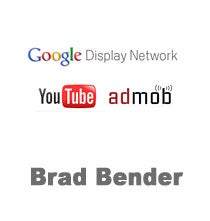 Brad Bender is Director of Product Management for Display at Google.
Brad Bender is Director of Product Management for Display at Google.
In an interview with AdExchanger.com, Bender recently touched on a few of the highlights from his presentation at the Citi Technology Conference on September 8 in New York City.
AdExchanger.com: At the recent Citi tech conference, you were asked how Google would take the display market from $20 billion to $200 billion and mentioned Procter & Gamble as an example of how Google will get there. Why?
BB: Procter & Gamble was just a hypothetical example of a brand advertiser, of course; the broader point is that more brand dollars moving online will be key to growing the overall display pie. Right now, it’s incredibly easy for brand marketers to spend the majority of their budgets in TV. Display is still, relatively, incredibly complicated. But online video, rich media and mobile all present unique opportunities for brands, and we’re starting to see brand dollars start to flow that way. The key is innovating to make the process of planning, running, and measuring a display campaign as easy as it is to send a tape to a TV network and hit ‘play.’
Looking at mobile display – which is going to be bigger, apps or mobile browser display?
We’re seeing huge growth in mobile across the board — our AdMob network now includes over 100K mobile websites and apps and receives over 2.7 billion ad requests every day. I’m not going to speculate whether mobile sites or apps will be bigger, I see huge room for growth on both sides. Clearly, the market for apps is only accelerating, especially as smartphone adoption takes off globally. On the mobile web side, most sites still are not optimized for mobile, meaning that users aren’t getting the best experience, when it comes to content and ads. I predict we’ll see more companies and content providers start to focus more on providing a great mobile experience for their customers, and that will spur even more mobile usage and investment.
Is there more that Google can do to coalesce search and display marketing?
Of course we can always do more – but I actually think we’ve made huge strides in this area this year. Our approach, from the outset, has been to take the insights we gained from search — specifically around how to provide measurability and accountability around campaign performance — and apply those to display. And it appears to be paying off for our partners. This year, we’ve seen more than two-thirds of our largest advertisers run both search and display campaigns and, year-over-year display spending from our largest 1,000 advertisers has doubled. Clearly they’re seeing the value. We’ve also introduced new ad formats, like media ads, that start to blur the line between search and display, as well as integrated DoubleClick for Search so that advertisers can compare performance across all of their paid search campaigns and display. We’re going to continue to innovate in display and make it more “search-like,” and work to provide our partners with metrics that can help them judge success across both search and display campaigns.
Along those lines, what can you say about Google’s efforts to bring it all together cross-channel and offer better attribution and/or media mix modeling? Where is Google today – where do you see it in the future?
When a customer buys on your site, most conversion tracking tools credit the most recent link or ad clicked. In reality though, customers research, compare and make purchase decisions via multiple touch points across multiple channels, so a lot of marketers are not seeing the full picture when it comes. So earlier this year, we introduced Multi-Channel Funnels, a set of reports that gives marketers more visibility into the full path to conversion over a 30 day period. This allows advertisers to compare interactions across various digital channels so they can understand how their channels work together to impact conversions. This is a great step towards where we’re going… providing insight not just into one piece of the puzzle, but into how all the pieces work together and interact with each other.
Where do you see YouTube uniquely fitting in the audience buying world?
Going back to your first question, I really think this comes back to the issue of how we bring more brand dollars online. Brand marketers are looking for “the next :30 second spot,” and I think they’re finding it in online video. We can combine video’s unparalleled ability to tell a story and create emotional engagement with online advertising’s ability to reach a specific audience at a large scale. Add to that mix real-time exchange buying, as we did earlier this year by making YouTube video inventory available on our exchange, and you start to see a really compelling offering for brand advertisers.
By John Ebbert













